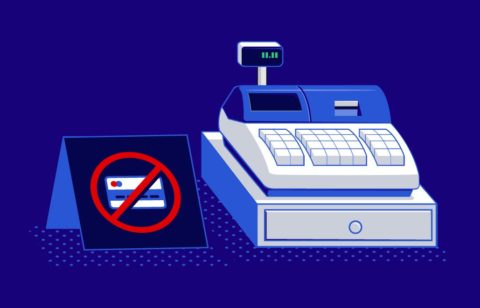You probably wouldn’t want to contact swine flu. It’s a nasty disease whose symptoms include fever, cough, sore throat, body aches, headache, chills and fatigue. Credit cards are like this in that if you don’t use them responsibly, you could end up experiencing headaches, body aches and feeling fatigued. To keep this from happening, here are eight credit card things you need to avoid like, well, swine flu.
1. Don’t fall for marketing hype
When choosing a credit card, don’t pick one because it has a great sign-up offer, has your favorite team’s logo or comes with rewards points or cash back. Choose one instead that has a low APR and that fits how you spend money. Would it be accepted at all your favorite restaurants and retailers? Does it have an annual fee? These are more important things to consider than rewards or great bonuses and it’s critical that you think about them.
If you’ve had credit problems in the past, you might be tempted to apply for one of those “pre-approved” credit cards. Unfortunately, these are often a marketing gimmick where you might meet some sort of criteria but pre-approval does not guarantee that you’ll actually get the card or that it would be right for you. Think carefully as to how you would use the card and research your options to get a card that would best fit your lifestyle and needs.
2. Don’t skip the fine print
While the 2009 CARD Act eliminated some specific credit card fees and requires the credit card companies to be more transparent about other fees, don’t make the mistake of thinking you’re totally protected from any and all credit card fees. These laws don’t protect you from everything. Before you sign up for any card, be sure to read its terms and conditions so you will know exactly what to expect. For example, with some cards if you miss a payment, your nice interest fee of 12.10% could automatically be jumped to a no-so-nice 19%.
3. Don’t make just the minimum payment
All credit card statements include a minimum payment or the amount you will need to pay to keep from missing a payment. You don’t want to ever make just that payment. Here’s why. Let’s suppose you have a balance of $1200 and your minimum payment is $42. You think, piece of cake. If I just pay the $42 I will still be good on my credit card. But this is not so. Your balance would still be $1200 and you would be charged an extremely high APR. For example, if your APR was 18% and you made only the minimum payment of $42 you would end up paying $$713.79 in interest payments and it would be 89 months before you were out of debt. And when you carry a balance forward on a rewards credit card you will probably be charged a higher interest rate than with a regular card that offers no rewards.
Here’s a video that uses a glass of water to demonstrate what happens if you make just the minimum payments on your credit card bill.
4. Take no cash advances
If you take a cash advance or do some other type of cash-like transaction, you will be charged interest from the minute you make the transaction. Plus, cash advances usually come with higher interest rates than when you make regular purchases. You might be tempted to use your credit card at an ATM or use one of those “convenience” checks but just tell yourself “no.” Both of these transactions will likely have high interest rates and extra fees.
5. Ignoring your statements and notices is a very bad idea
Credit card statements sometimes include what are called “gray” charges. While these charges are technically legal, you may not have authorized them. This could be membership fees from a health club you thought you had canceled or charges for downloaded ring tones that were tacked on by your cell phone company. Whenever you receive a statement be sure to review it carefully looking for those gray charges. If you find one, try to first resolve things with the retailer. If that doesn’t work, dispute the charge or charges with your credit card company. You need to carefully go over every credit card statement to make sure there are no fraudulent charges and none that you don’t recognize.
6. Never max out a card
When you use up all your available credit, this will not only cost you money but may damage your credit score. This is because 30% of your score is based on your credit utilization – or how much credit you’ve used vs. the total amount you have available. This is expressed as your debt-to-credit ratio. If you had a total of $2,000 in credit available and had used up $1,000 of it, your debt-to-credit ratio would be 50% (amount of credit used divided by total amount available), which would be too high. Most experts say that your debt-to-credit ratio should be no higher than 30% and the lower the better. When you have a debt-to-credit ratio of 40% or more it makes it look as if you were desperate and that you need credit to just subsist. Since the credit card companies don’t like to see this, they may raise your interest rate or try to reduce the amount of credit you have available – to rein in your spending and reduce their risks. If you do have a debt-to-credit ratio of 40% or higher, try to pay down your debt as this would lower your debt-to-credit ratio and could boost your credit score.
7. Don’t miss a due date
Every credit card has a grace period or the amount of time between when your billing cycle ends and your payment is due. If you miss a due date this can lower your credit score by as many as 60 points and will probably trigger an increase in your interest rate. Your due date is really your due date. If you have a problem remembering when it is, put a reminder on your calendar to make sure you don’t miss it. We use a calendar that allows us to set a reminder on a certain date and it will then pop up on that day every month. If you use multiple credit cards, you might contact your card issuers and have your billing dates changed so they all hit on the same day. An even better idea is to set up automatic payments so you won’t be derailed by a check that got lost in the mail or because you forgot a payment. We use online banking and whenever we receive a statement from one of our credit card companies the first thing we do is go online and schedule a payment for a few days before it’s due. We do this because that eliminates the possibility of missing a payment and gives us more flexibility than if we had automated it.
8. Don’t get in the habit of chasing miles or points
If you have a card (or cards) that come with points, miles or cash back, it can be very tempting to use it to buy stuff you don’t really need. If you need a new tablet, buy it because you need it and not because you want to earn points. And if you’re trying to earn enough points to get a $300 plane ticket you will end up spending several times that amount to get the equivalent in points or miles. In fact, in many cases you would be money ahead to just buy the plane ticket. There have been studies done that showed people spent more when paying with a credit card than with cash and even more when paying with a rewards card. These cards are designed to get you to buy more and can be very enticing. But be very careful and don’t run up a lot of charges believing that getting those points or miles will make it all worthwhile.
What do those numbers on your credit card really mean?
Every credit card has a 16-digit number. Have you ever wondered if those numbers meant something and if so, what? Here’s an infographic that “cracks the code.”





